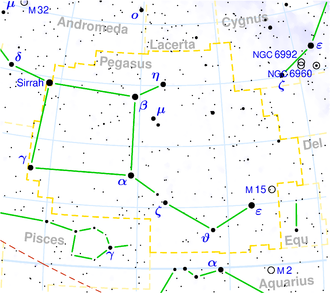NGC 7366
| Galaxy NGC 7366 |
|
|---|---|

|
|
| SDSS recording | |
| AladinLite | |
| Constellation | Pegasus |
|
Position equinox : J2000.0 , epoch : J2000.0 |
|
| Right ascension | 22 h 44 m 26.6 s |
| declination | + 10 ° 46 ′ 53 ″ |
| Appearance | |
| Morphological type | S. |
| Brightness (visual) | 14.4 mag |
| Brightness (B-band) | 15.2 mag |
| Angular expansion | 0.4 ′ × 0.4 ′ |
| Surface brightness | 12.3 mag / arcmin² |
| Physical data | |
| Redshift | 0.038807 ± 0.000160 |
| Radial velocity | 11,634 ± 48 km / s |
|
Stroke distance v rad / H 0 |
(527 ± 37) · 10 6 Lj (161.7 ± 11.3) Mpc |
| history | |
| discovery | Albert Marth |
| Discovery date | August 7, 1864 |
| Catalog names | |
| NGC 7366 • PGC 69629 • MCG + 02-58-004 • 2MASX J22442662 + 1046528 • | |
NGC 7366 is a spiral galaxy of Hubble type S in the constellation Pegasus at the northern sky . It is estimated to be 527 million light years away from the Milky Way and has a diameter of around 60,000 ly.
In the same area of the sky are the galaxies NGC 7370 , NGC 7372 , NGC 7374 , IC 1452 .
The object was discovered by Albert Marth on August 7, 1864 .
